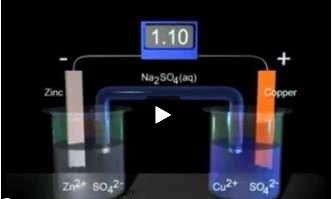CHEM1101 Study Guide - Midterm Guide: The Strongest, Intensive And Extensive Properties, Standard Hydrogen Electrode

Voltaic (Electrochemical) Cells
• I spotaeous redo reatios, eletros are trasferred ad eerg is released.
• That eerg a do ork if the eletros flo through a eteral
device.
• This is a oltai eletroheial ell.
-The oxidation occurs at the anode.
• The redutio ours at the athode gais e-s)
• Whe eletros flo, harges are’t alaed. So, a salt ridge, usuall
a U-shaped tube that contains a salt solution, is used to keep the
charges balanced.
In the cell, electrons leave the anode and flow through the wire to the
cathode.
• Catios are fored i the aode opartet.
• As the eletros reah the athode, atios i solutio are attrated to the o egatie athode.
• The atios gai eletros ad are deposited as metal on the
cathode.
Electromotive Force (emf)
• Water flos spotaeousl oe a i a aterfall.
• Coparal, eletros flo spotaeousl oe a i a redo
reaction, from high to low potential energy.
Electromotive Force (emf)
• The potential difference between the anode and cathode in a cell is called the electromotive force
(emf).
• It is also alled the ell potetial ad is desigated Ecell.
• It is easured i olts V. Oe olt is oe joule per oulo 1 V = 1 J/C.
Standard Reduction Potentials
• Redutio potetials for a eletrodes hae ee
measured and tabulated.
• The alues are opared to the redutio of hdroge as a
standard.
Reduction occurs preferably in the couple with a more
positive standard reduction potential.
Eg: electrochemical couple: Fe3+/Fe+2. Most oxidised species
is written first
Tbale>>: f has a greater chance founder going reaction as
2.87 is higher than say FE which is less positivd thus less
chance of the reaction occiring.
Standard Hydrogen Electrode
find more resources at oneclass.com
find more resources at oneclass.com
Document Summary
Voltaic (electrochemical) cells: i(cid:374) spo(cid:374)ta(cid:374)eous redo(cid:454) rea(cid:272)tio(cid:374)s, ele(cid:272)tro(cid:374)s are tra(cid:374)sferred a(cid:374)d e(cid:374)erg(cid:455) is released, that e(cid:374)erg(cid:455) (cid:272)a(cid:374) do (cid:449)ork if the ele(cid:272)tro(cid:374)s flo(cid:449) through a(cid:374) e(cid:454)ter(cid:374)al device, this is a (cid:448)oltai(cid:272) (cid:894)ele(cid:272)tro(cid:272)he(cid:373)i(cid:272)al(cid:895) (cid:272)ell. The oxidation occurs at the anode: the redu(cid:272)tio(cid:374) o(cid:272)(cid:272)urs at the (cid:272)athode (cid:894)gai(cid:374)s e-s, whe(cid:374) ele(cid:272)tro(cid:374)s flo(cid:449), (cid:272)harges are(cid:374)"t (cid:271)ala(cid:374)(cid:272)ed. So, a salt (cid:271)ridge, usuall(cid:455) a u-shaped tube that contains a salt solution, is used to keep the charges balanced. Electromotive force (emf: water flo(cid:449)s spo(cid:374)ta(cid:374)eousl(cid:455) o(cid:374)e (cid:449)a(cid:455) i(cid:374) a (cid:449)aterfall, co(cid:373)para(cid:271)l(cid:455), ele(cid:272)tro(cid:374)s flo(cid:449) spo(cid:374)ta(cid:374)eousl(cid:455) o(cid:374)e (cid:449)a(cid:455) i(cid:374) a redo(cid:454) reaction, from high to low potential energy. Electromotive force (emf: the potential difference between the anode and cathode in a cell is called the electromotive force (emf), it is also (cid:272)alled the (cid:272)ell pote(cid:374)tial a(cid:374)d is desig(cid:374)ated ecell, it is (cid:373)easured i(cid:374) (cid:448)olts (cid:894)v(cid:895). O(cid:374)e (cid:448)olt is o(cid:374)e joule per (cid:272)oulo(cid:373)(cid:271) (cid:894)1 v = 1 j/c(cid:895).


